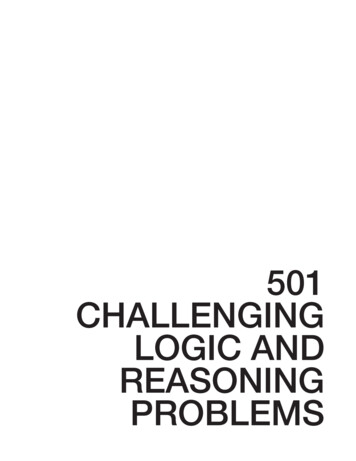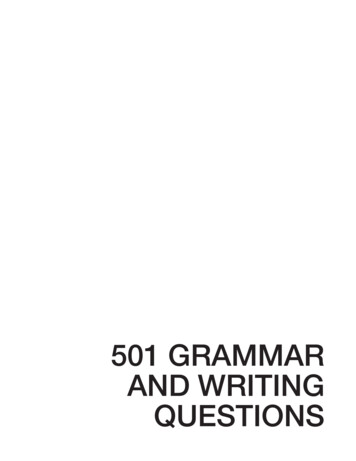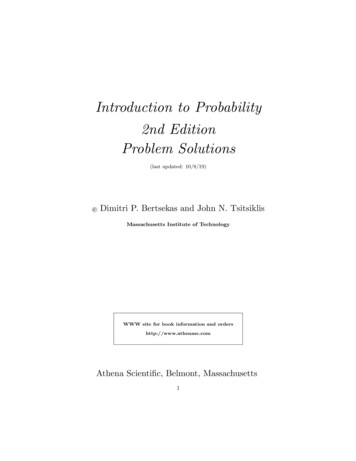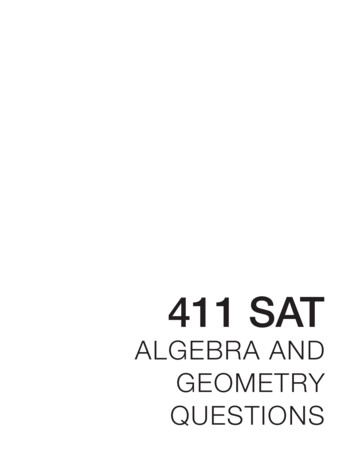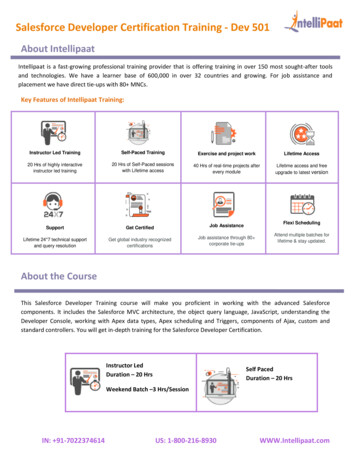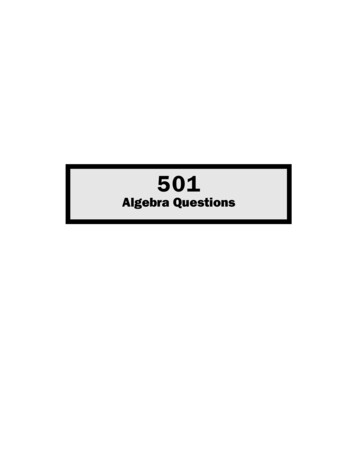
Transcription
501Algebra Questions
501Algebra Questions2nd Edition NEW YORK
Copyright 2006 LearningExpress, LLC.All rights reserved under International and Pan-American Copyright Conventions.Published in the United States by LearningExpress, LLC, New York.Library of Congress Cataloging-in-Publication Data:501 algebra questions.—2nd ed.p. cm.Rev. ed. of: 501 algebra questions / [William Recco]. 1st ed. 2002.ISBN 1-57685-552-X1. Algebra—Problems, exercises, etc. I. Recco, William. 501 algebraquestions. II. LearningExpress (Organization). III. Title: Five hundred onealgebra questions. IV. Title: Five hundred and one algebra questions.QA157.A15 2006512—dc222006040834Printed in the United States of America9 8 7 6 5 4 3 21Second EditionISBN 1-57685-552-XFor more information or to place an order, contact LearningExpress at:55 Broadway8th FloorNew York, NY 10006Or visit us at:www.learnatest.com
The LearningExpress Skill Builder in Focus Writing Team iscomprised of experts in test preparation, as well as educators andteachers who specialize in language arts and math.LearningExpress Skill Builder in Focus Writing TeamBrigit DermottFreelance WriterEnglish Tutor, New York CaresNew York, New YorkSandy GadeProject EditorLearningExpressNew York, New YorkKerry McLeanProject EditorMath TutorShirley, New YorkWilliam ReccoMiddle School Math Teacher, Grade 8New York Shoreham/Wading River School DistrictMath TutorSt. James, New YorkColleen SchultzMiddle School Math Teacher, Grade 8Vestal Central School DistrictMath TutorVestal, New York
ContentsIntroductionix1Working with Integers12Working with Algebraic Expressions123Combining Like Terms244Solving Basic Equations415Solving Multi-Step Equations496Solving Equations with Variables on Both Sidesof an Equation587Using Formulas to Solve Equations728Graphing Linear Equations819Solving Inequalities11010 Graphing Inequalities11911 Graphing Systems of Linear Equationsand Inequalities14212 Solving Systems of Equations Algebraically17213 Working with Exponents186
Contents14 Multiplying Polynomials19415 Factoring Polynomials20616 Using Factoring21517 Solving Quadratic Equations22918 Simplifying Radicals24219 Solving Radical Equations25020 Solving Equations with the Quadratic Formula261viii
IntroductionThis book is designed to provide you with review and practice for algebrasuccess! It is not intended to teach common algebra topics. Instead, it provides501 problems so you can flex your muscles and practice a variety of mathematical and algebraic skills. 501 Algebra Questions is designed for many audiences. It’s for anyone who has ever taken a course in algebra and needs torefresh and revive forgotten skills. It can be used to supplement current instruction in a math class. Or, it can be used by teachers and tutors who need to reinforce student skills. If, at some point, you feel you need further explanationabout some of the algebra topics highlighted in this book, you can find them inthe LearningExpress publication Algebra Success in 20 Minutes a Day.How to Use This BookFirst, look at the table of contents to see the types of algebra topics covered inthis book. The book is organized into 20 chapters with a variety of arithmetic,algebra, and word problems. The structure follows a common sequence of concepts introduced in basic algebra courses. You may want to follow the sequence,as each succeeding chapter builds on skills taught in previous chapters. But if
501 Algebra Questionsyour skills are just rusty, or if you are using this book to supplement topics you arecurrently learning, you may want to jump around from topic to topic.Chapters are arranged using the same method. Each chapter has an introductiondescribing the mathematical concepts covered in the chapter. Second, there arehelpful tips on how to practice the problems in each chapter. Last, you are presented with a variety of problems that generally range from easier to more difficultproblems and their answer explanations. In many books, you are given one modelproblem and then asked to do many problems following that model. In this book,every problem has a complete step-by-step explanation for the solutions. If you findyourself getting stuck solving a problem, you can look at the answer explanation anduse it to help you understand the problem-solving process.As you are solving problems, it is important to be as organized and sequential inyour written steps as possible. The purpose of drills and practice is to make you proficient at solving problems. Like an athlete preparing for the next season or a musician warming up for a concert, you become skillful with practice. If, aftercompleting all the problems in a section, you feel that you need more practice, dothe problems over. It’s not the answer that matters most—it’s the process and thereasoning skills that you want to master.You will probably want to have a calculator handy as you work through some ofthe sections. It’s always a good idea to use it to check your calculations. If you havedifficulty factoring numbers, the multiplication chart on the next page may helpyou. If you are unfamiliar with prime numbers, use the list on the next page so youwon’t waste time trying to factor numbers that can’t be factored. And don’t forgetto keep lots of scrap paper on hand.Make a CommitmentSuccess does not come without effort. Make the commitment to improve your algebra skills. Work for understanding. Why you do a math operation is as importantas how you do it. If you truly want to be successful, make a commitment to spendthe time you need to do a good job. You can do it! When you achieve algebra success, you have laid the foundation for future challenges and success. So sharpenyour pencil and practice!x
501 Algebra Questions 617677751823883967Multiplication 556677889960728496108Commonly 1732292813494094635416016597338098639411,013
501Algebra Questions
1Working withIntegersFor some people, it is helpful to try to simplify expressions containingsigned numbers as much as possible. When you find signed numbers withaddition and subtraction operations, you can simplify the task by changingall subtraction to addition. Subtracting a number is the same as adding itsopposite. For example, subtracting a three is the same as adding a negativethree. Or subtracting a negative 14 is the same as adding a positive 14. Asyou go through the step-by-step answer explanations, you will begin to seehow this process of using only addition can help simplify your understanding of operations with signed numbers. As you begin to gain confidence,you may be able to eliminate some of the steps by doing them in your headand not having to write them down. After all, that’s the point of practice!You work at the problems until the process becomes automatic. Then youown that process and you are ready to use it in other situations.The Tips for Working with Integers section that follows gives yousome simple rules to follow as you solve problems with integers. Refer tothem each time you do a problem until you don’t need to look at them.That’s when you can consider them yours.You will also want to review the rules for Order of Operations withnumerical expressions. You can use a memory device called a mnemonicto help you remember a set of instructions. Try remembering the wordPEMDAS. This nonsense word helps you remember to:
501 Algebra QuestionsPEMDASdo operations inside Parenthesesevaluate terms with Exponentsdo Multiplication and Division in order from left to rightAdd and Subtract terms in order from left to rightTips for Working with IntegersAdditionSigned numbers the same? Find the SUM and use the same sign. Signed numbers different? Find the DIFFERENCE and use the sign of the larger number. (The larger number is the one whose value without a positive or negativesign is greatest.)Addition is commutative. That is, you can add numbers in any order andthe result is the same. As an example, 3 5 5 3, or –2 –1 –1 –2.SubtractionChange the operation sign to addition, change the sign of the number following the operation, then follow the rules for addition.Multiplication/DivisionSigns the same? Multiply or divide and give the result a positive sign. Signsdifferent? Multiply or divide and give the result a negative sign.Multiplication is commutative. You can multiply terms in any order and theresult will be the same. For example: (2 5 7) (2 7 5) (5 2 7) (5 7 2) and so on.Evaluate the following expressions.1. 27 52. 18 20 163. 15 74. 33 165. 8 4 126. 38 2 97. 258. 5· 3 15 · 5· 9 · 29. 24 · 8 210. 2 · 3 · 711. 15 5 112
501 Algebra Questions12. (49 7) (48 4)13. 3 7 14 514. (5· 3) (12 4)15. ( 18 2) (6 · 3)16. 23 (64 16)17. 23 ( 4)218. (3 5)3 (18 6)219. 21 (11 8)320. (32 6) ( 24 8)21. A scuba diver descends 80 feet, rises 25 feet, descends 12 feet, and thenrises 52 feet where he will do a safety stop for five minutes beforesurfacing. At what depth did he do his safety stop?22. A digital thermometer records the daily high and low temperatures. Thehigh for the day was 5 C. The low was 12 C. What was the differencebetween the day’s high and low temperatures?23. A checkbook balance sheet shows an initial balance for the month of 300.During the month, checks were written in the amounts of 25, 82, 213,and 97. Deposits were made into the account in the amounts of 84 and 116. What was the balance at the end of the month?24. A gambler begins playing a slot machine with 10 in quarters in her coinbucket. She plays 15 quarters before winning a jackpot of 50 quarters. Shethen plays 20 more quarters in the same machine before walking away.How many quarters does she now have in her coin bucket?25. A glider is towed to an altitude of 2,000 feet above the ground beforebeing released by the tow plane. The glider loses 450 feet of altitudebefore finding an updraft that lifts it 1,750 feet. What is the glider’saltitude now?3
501 Algebra QuestionsAnswersNumerical expressions in parentheses like this [ ] are operations performed on only part of the originalexpression. The operations performed within these symbols are intended to show how to evaluate thevarious terms that make up the entire expression.Expressions with parentheses that look like this ( ) contain either numerical substitutions or expressions that are part of a numerical expression. Once a single number appears within these parentheses,the parentheses are no longer needed and need not be used the next time the entire expression iswritten.When two pair of parentheses appear side by side like this ( )( ), it means that the expressions withinare to be multiplied.Sometimes parentheses appear within other parentheses in numerical or algebraic expressions.Regardless of what symbol is used, ( ), { }, or [ ], perform operations in the innermost parentheses firstand work outward.Underlined expressions show the original algebraic expression as an equation with the expressionequal to its simplified result.1. The signs of the terms are different, so find the differenceof the values.The sign of the larger term is positive, so the sign ofthe result is positive.2. Change the subtraction sign to addition bychanging the sign of the number that follows it.Since all the signs are negative, add theabsolute value of the numbers.Since the signs were negative, the resultis negative.The simplified result of the numeric expressionis as follows:3. Change the subtraction sign to addition bychanging the sign of the number that follows it.Signs different? Subtract the absolute value ofthe numbers.Give the result the sign of the larger term.The simplified expression is as follows:4. Signs different? Subtract the value of the numbers.Give the result the sign of the larger term.4[27 5 22]27 5 22 18 20 ( 16)[18 20 16 54] 18 20 16 54 18 20 16 54 15 7[15 7 8] 15 7 8 15 7 8[33 16 17]33 16 17
501 Algebra Questions5. Change the subtraction sign to addition by changing8 4 128 ( 4 12)the sign of the number that follows it.With three terms, first group like terms and add.Signs the same? Add the value of the terms andgive the result the same sign.Substitute the result into the first expression.Signs different? Subtract the value of the numbers.Give the result the sign of the larger term.The simplified result of the numeric expressionis as follows:6. First divide. Signs different? Divide and give theresult the negative sign.Substitute the result into the expression.Signs different? Subtract the value of the numbers.Give the result the sign of the term with thelarger value.The simplified result of the numeric expressionis as follows:[( 4 12) 16]8 ( 16)[16 8 8]8 ( 16) 88 4 12 8[(38 2) 19]( 19) 9[19 9 10]( 19) 9 1038 2 9 107. First perform the multiplications.Signs the same? Multiply the terms and givethe result a positive sign.Signs different? Multiply the terms and givethe result a negative sign.Now substitute the results into the originalexpression.Signs different? Subtract the value of thenumbers.The simplified result of the numericexpression is as follows:[ 25 · 3 75][15 · 5 75]( 75) ( 75)[75 75 0] 25· 3 15 · 5 08. Because all the operators are multiplication, youcould group any two terms and the result wouldbe the same. Let’s group the first two terms.Signs the same? Multiply the terms and givethe result a positive sign.Now substitute the result into the originalexpression.Signs different? Multiply the terms and givethe result a negative sign.The simplified result of the numeric expressionis as follows:5( 5 · 9) · 2[5 · 9 45] 45· 2 45· 2 90 5· 9 · 2 90
501 Algebra Questions(24 · 8) 29. Group the terms being multiplied and evaluate.Signs different? Multiply the terms and give theresult a negative sign.Substitute.Signs different? Subtract the value of the terms.Give the result the sign of the term with thelarger value.The simplified result of the numeric expressionis as follows:[24 · 8 192]( 192) 2[192 2 190]( 192) 2 19024 · 8 2 19010. Because all the operators are multiplication, youcould group any two terms and the result would bethe same. Let’s group the last two terms.Signs the same? Multiply the terms and give theresult a positive sign.Substitute.Signs the same? Multiply the terms and give theresult a positive sign.The simplified result of the numeric expression isas follows:2 · ( 3 · 7)[( 3 · 7) 21]2 · ( 21)2 · ( 21) 422 · 3 · 7 4211. Because all the operators are addition, you couldgroup any two terms and the result would be thesame. Or you could just work from left to right.Signs different? Subtract the value of the numbers.Give the result the sign of the term with thelarger value.Substitute.Signs the same? Add the value of the termsand give the result the same sign.The simplified result of the numeric expressionis as follows:( 15 5) 11[15 5 10][( 15 5) 10]( 10) 11[10 11 21]( 10) 11 21 15 5 11 2112. First evaluate the expressions within theparentheses.Signs different? Divide and give the resulta negative sign.Substitute into the original expression.Change the subtraction sign to additionby changing the sign of the number thatfollows it.Signs the same? Add the value of the termsand give the result the same sign.The simplified result of the numericexpression is as follows:6[49 7 7][48 4 12](7) ( 12)7 127 12 19(49 7) (48 4) 19
501 Algebra Questions13. Change the subtraction sign to addition by3 7 14 5(3 7) 14 5changing the sign of the number that follows it.Now perform additions from left to right.Signs different? Subtract the value of the numbersand give the result the sign of the higher valuenumber.[7 3 4][3 7 4]( 4) 14 5( 4 14) 5Substitute.Add from left to right.Signs the same? Add the value of the terms andgive the result the same sign.Substitute.Signs different? Subtract the value of thenumbers and give the result the sign of thehigher value number.[ 4 14 18]( 18) 5[18 5 13]( 18) 5 13The simplified result of the numeric expressionis as follows:3 7 14 5 1314. First evaluate the expressions within theparentheses.Signs different? Divide and give the resulta negative sign.Substitute the values into the originalexpression.Signs the same? Add the value of the termsand give the result the same sign.The simplified result of the numericexpression is as follows:7[5 · 3 15][12 4 3] (15) ( 3)[15 3 18] (15) ( 3) 18 (5· 3) (12 4) 18
501 Algebra Questions15. First evaluate the expressions within theparentheses.Signs different? Divide the value of theterms and give the result a negative sign.Signs different? Multiply the term valuesand give the result a negative sign.Substitute the values into the originalexpression.Change subtraction to addition and changethe sign of the term that follows.Signs different? Subtract the value of thenumbers and give the result the sign of thehigher value number.The simplified result of the numericexpression is as follows:16. Evaluate the expressions within the parentheses.Signs different? Divide and give the resulta negative sign.Substitute the value into the original expression.Signs different? Subtract the value of thenumbers and give the result the sign of thehigher value number.The simplified result of the numeric expressionis as follows:[( 18 2)][18 2 9][( 18 2 9)](6 · 3)[6 · 3 18](6 · 3) 18( 9) ( 18)( 9) ( 18)[18 9 9]( 9) ( 18) 9( 18 2) (6 · 3) 9(64 16)[64 16 4](64 16 4)23 ( 4)[23 4 19]23 ( 4) 1923 (64 16) 1917. The order of operations tells us to evaluate the[23 2 · 2 · 2 8][( 4)2 ( 4) · ( 4)]terms with exponents first.Signs the same? Multiply the terms and givethe result a positive sign.Substitute the values of terms with exponentsinto the original expression.Change subtraction to addition and changethe sign of the term that follows.Signs different? Subtract the value of thenumbers and give the result the sign of thehigher value number.8[4 · 4 16][( 4)2 16]23 ( 4)2 (8) ( 16)8 16[16 8 8]8 16 8
501 Algebra QuestionsThe simplified result of the numeric expressionis as follows:18. First evaluate the expressions within theparentheses.Change subtraction to addition and changethe sign of the term that follows.Signs different? Subtract the value of thenumbers and give the result the sign of thehigher value number.Substitute the values of the expressions inparentheses into the original expression.Evaluate the terms with exponents.Signs different? Multiply the value of theterms and give the result a negative sign.Substitute the values into the expression.Signs different? Subtract the value of thenumbers and give the result the sign of thehigher value number.The simplified result of the numericexpression is as follows:23 ( 4)2 8[3 5][3 ( 5)][5 3 2][3 5 2][18 6 3]( 2)3 (3)2[( 2)3 2 · 2 · 2][( 2 · 2) · 2 ( 4) · 2][( 4) · 2 8][(3)2 3 · 3 9]( 2)3 (3)2 8 99 8 1(3 5)3 (18 6)2 119. First evaluate the expression within the parentheses.Signs different? Subtract the value of the numbersand give the result the sign of the higher valuenumber.Substitute the value into the expression.Evaluate the term with the exponent.Substitute the value into the expression.The simplified result of the numeric expression isas follows:[11 8][11 8 3][11 8 3]21 ( 3)3[( 3)3 33 27]21 (27) 4821 (11 8)3 4820. First evaluate the expressions within the[32 6 (9) 6 15]parentheses.Signs different? Divide and give the resultthe negative sign.Substitute values into the original expression.Signs different? Divide the value of theterms and give the result a negative sign.[ 24 8 3](15) ( 3)The simplified result of the numericexpression is as follows:(32 6) ( 24 8) 59[15 3 5](15) ( 3) 5
501 Algebra Questions21. If you think of distance above sea level as a positive number, then you mustthink of going below sea level as a negative number. Going up is in thepositive direction, while going down is in the negative direction. Give allthe descending distances a negative sign and the ascending distances apositive sign.The resulting numerical expression would be 80 25 12 52as follows:Because addition is commutative, you canassociate like-signed numbers.( 80 12) ( 25 52)Evaluate the numerical expression in eachparentheses.[ 80 12 92][ 25 52 77]Substitute the values into the numericalexpression.( 92) ( 77)Signs different? Subtract the value of thenumbers and give the result the sign of thehigher value number.[92 77 15] The diver took his rest stop at 15 feet.22. You could simply figure that 5 C is 5 above zero and 11 C is 11 below. So the difference is the total of 5 11 16 .Or you could find the difference between 5 and 11 .That would be represented by the following 5 11 5 11 16 equation.23. You can consider that balances and deposits are positive signed numbers,while checks are deductions, represented by negative signed numbers.An expression to representthe activity during the monthwould be as follows:300 25 82 213 97 84 116Because addition is commutative, you can associatelike signed numbers.(300 84 116) ( 25 82 213 97)Evaluate the numberswithin each parentheses.[300 84 116 500][( 25 82 213 97 417]Substitute the values intothe revised expression.( 500) ( 417) 83The balance at the end of the month would be 83.10
501 Algebra Questions24. You first figure out how many quarters she startswith. Four quarters per dollar gives you 4 · 10 40 quarters. You can write an expression thatrepresents the quarters in the bucket and thequarters added and subtracted. In chronologicalorder, the expression would be as follows:40 15 50 20Change all operation signs to addition andthe sign of the number that follows.40 15 50 20Because addition is commutative, you canassociate like-signed numbers.(40 50) ( 15 20)Use the rules for adding integers with likesigns.[40 50 90][ 15 20 35]Substitute into the revised expression.(90) ( 35)Signs different? Subtract the value of thenumbers and give the result the sign of thehigher value number.[90 35 55]The simplified result of the numericexpression is as follows:40 15 50 20 5525. As in problem 21, ascending is a positive number while descending is a neg-ative number. You can assume ground level is the zero point.An expression that represents the problem 2,000 450 1,750is as follows:Because addition is commutative, you canassociate like-signed numbers.( 2,000 1,750) 450Evaluate the expression in the parentheses.[ 2,000 1,750 3,750]Substitute into the revised equation.( 3,750) 450Signs different? Subtract the value of thenumbers and give the result the sign of thehigher value number.[3,750 450 3,300]The simplified result of the numericexpression is as follows:( 3,750) 450 3,30011
2Working withAlgebraic ExpressionsThis chapter contains 25 algebraic expressions; each can contain up tofive variables. Remember that a variable is just a letter that represents anumber in a mathematical expression. When given numerical values for thevariables, you can turn an algebraic expression into a numerical one.As you work through the problems in this chapter, you are to substitutethe assigned values for the variables into the expression and evaluate theexpression. You will be evaluating expressions very much like the previousnumerical expressions. The answer section contains complete explanationsof how to go about evaluating the expressions. Work on developing a similar style throughout, and you will have one sure way of solving these kindsof problems. As you become more familiar and comfortable with the lookand feel of these expressions, you will begin to find your own shortcuts.Read through the Tips for Working with Algebraic Expressionsbefore you begin to solve the problems in this section.Tips for Working with Algebraic Expressions Substitute assigned values for the variables into the expression.Use PEMDAS to perform operations in the proper order.Recall and use the Tips for Working with Integers fromChapter 1.
501 Algebra QuestionsEvaluate the following algebraic expressions whena 3b 5x 61y 2 z 8 26. 4a z27. 3x z28. 2ax z29. 5ab xy30. 4b2 az31. 7x 2yz32. bx z y33. 6y 2ab34. a(b z)235. 2(a2 2y) b36. a3 24y 3b37. 2x b az38. 5z2 2z 239. 5xy 2b1240. 7x x z41. 2b2 y42. bx(z 3)43. 6y(z y) 3ab44. 2bx (z b)45. 12ab yx46. y{( 2 3) 4a}47. 10b3 4b248. 8y(a3 2y)49. z2 4a2y50. 3x2b(5a 3b)13
501 Algebra QuestionsAnswersNumerical expressions in parentheses like this [ ] are operations performed on only part of the originalexpression. The operations performed within these symbols are intended to show how to evaluate thevarious terms that make up the entire expression.Expressions with parentheses that look like this ( ) contain either numerical substitutions or expressions that are part of a numerical expression. Once a single number appears within these parentheses,the parentheses are no longer needed and need not be used the next time the entire expression iswritten.When two pair of parentheses appear side by side like this ( )( ), it means that the expressions withinare to be multiplied.Sometimes parentheses appear within other parentheses in numerical or algebraic expressions.Regardless of what symbol is used, ( ), { }, or [ ], perform operations in the innermost parentheses firstand work outward.Underlined expressions show the original algebraic expression as an equation with the expressionequal to its simplified result.a 3b 5x 61y 2 z 826. Substitute the values for the variables into the expression.Order of operations tells you to multiply first.Substitute.Signs different? Subtract the value of the numbers.Give the result the sign of the larger value. (No signmeans )The value of the expression is as follows:27. Substitute the values for the variables into theexpression.PEMDAS: Multiply the first term.Substitute.Signs different? Divide and give the result thenegative sign.1( 2 4 )The value of the expression is as follows: 44a z 43(6) ( 8)[3(6) 18](18) ( 8)2141[18 8 2 8 2 4 ]13x z 2 4 or 2.2528. Substitute the values for the variables into the expression.Multiply the factors of the first term.Substitute.Change the operator to addition and the sign of thenumber that follows.Signs the same? Add the value of the terms and give theresult the same sign.4(3) ( 8)[4(3) 12](12) ( 8)12 8 42(3)(6) ( 8)[2(3)(6) 36](36) ( 8)(36) ( 8)[36 8 44]
501 Algebra Questions( 44)2ax z 44The simplified value of the expression is as follows:29. Substitute the values for the variables into theexpression.Evaluate the first term of the expression.Signs different? Multiply the terms and give theresult a negative sign.Evaluate the second term of the expression.Substitute the equivalent values into the originalexpression.Signs different? Subtract the value of the numbers.Give the result the sign of the larger value.The simplified value of the expression is as follows:30. Substitute the values for the variables into theexpression.PEMDAS: Evaluate the term with the exponent.Signs the same? Multiply the terms and give theresult a positive sign.Substitute.Now evaluate the other term.Signs different? Multiply and give the result anegative sign.Substitute the equivalent values into the originalexpression.Change the operator to addition and the sign ofthe number that follows.The simplified value of the expression is as follows:31. Substitute the values for the variables into theexpression.PEMDAS: Multiply the terms in theexpression.Substitute the equivalent values into theoriginal expression.Signs different? Divide and give the result anegative sign.The simplified value of the expression isas follows:1515(3)( 5) (6)( 2 )[5(3)( 5) 15( 5)][15( 5) 75]1[(6)( 2 ) 3]( 75) (3)[75 3 72]( 72)5ab xy 724( 5)2 (3)( 8)[( 5)2 ( 5) · ( 5)][5 · 5 25 25][4( 25) 100][(3)( 8)][3 · 8 24](100) ( 24)100 24 1244b2 az 12417(6) 2( 2 )( 8)[7 · 6 42]1[{2( 2 )}( 8) (1)( 8) 8](42) ( 8)[42 8 5.25](42) ( 8) 5.257x 2yz 5.25
501 Algebra Questions32. Substitute the values for the variables intothe expression.Group terms using order of operations.PEMDAS: Multiply or divide the terms inthe expression.Signs different? Multiply and give the resulta negative sign.Consider the second term.Signs different? Divide and give the resulta negative sign.To divide by a fraction, you multiply bythe reciprocal.1( 5)(6) ( 8) ( 2 )1( 5)(6) {( 8) ( 2 )}[( 5)(6)][5 · 6 30][( 5)(6) 30]1[( 8) ( 2 )]1[8 2 ]12[8 2 8 · 1 8 · 2 16]1Substitute the equivalent values into theoriginal expression.Signs the same? Add th
Aug 23, 2017 · xi Multiplication Table 23456789101112 2 4681012 141618202224 3 6 9 121518212427303336 4 8 12162024283236404448 5 10 15 20 25 30 35 40 45 50 55 60 6 12 18 24 30 36 42 48 54 60 66 72 7 14 21 28 35 42 49 56 63 70 77 84 8 16 24 32 40 48 56 64 72 80 88 96 9 18 27 36 45 54 63 72 81 90 99
